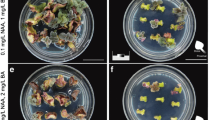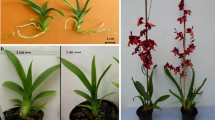Abstract
A high frequency of embryogenesis and transformation from all parts of flowers of two lines of Medicago truncatula R-108–1 and Jemalong J5 were obtained. Using this flower system, we obtained transgenic plants expressing promoter-uidA gene fusions as well as the gfp living cell color reporter gene. Moreover, this method allows us to save time and to use a smaller greenhouse surface for the culture of donor plants. Southern hybridization showed that the internal gfp fragment had the expected size and the number of T-DNA copies integrated in the plant genome varied between one and three. These data suggest that the presence of the GFP protein has no toxic effects, since no rearrangement of the gfp reporter gene was detected in the regenerated plants.
Similar content being viewed by others
Author information
Authors and Affiliations
Additional information
Received: 25 May 1999 / Revision received: 2 August 1999 / Accepted: 2 August 1999
Rights and permissions
About this article
Cite this article
Kamaté, K., Rodriguez-Llorente, I., Scholte, M. et al. Transformation of floral organs with GFP in Medicago truncatula. Plant Cell Reports 19, 647–653 (2000). https://doi.org/10.1007/s002999900168
Issue Date:
DOI: https://doi.org/10.1007/s002999900168




